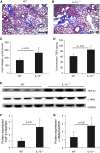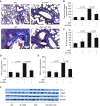Attenuation of Allergen-, IL-13-, and TGF-α-induced Lung Fibrosis after the Treatment of rIL-15 in Mice
- PMID: 30702923
- PMCID: PMC6604217
- DOI: 10.1165/rcmb.2018-0254OC
Attenuation of Allergen-, IL-13-, and TGF-α-induced Lung Fibrosis after the Treatment of rIL-15 in Mice
Erratum in
-
Erratum: Attenuation of Allergen-, IL-13-, and TGF-α-induced Lung Fibrosis after the Treatment of rIL-15 in Mice.Am J Respir Cell Mol Biol. 2021 Aug;65(2):229-230. doi: 10.1165/rcmb.v65erratum2. Am J Respir Cell Mol Biol. 2021. PMID: 34328408 Free PMC article. No abstract available.
Abstract
Endogenous IL-15 deficiency promotes lung fibrosis; therefore, we examined the effect of induced IL-15 in restricting the progression of lung fibrosis. Our objective in this work was to establish a novel therapeutic molecule for pulmonary fibrosis. Western blot, qPCR, and ELISA were performed on the lung tissues of IL-15-deficient mice, and recombinant IL-15 (rIL-15)-treated CC10-IL-13 and CC10-TGF-α mice, and allergen-challenged CC10-IL-15 mice were examined to establish the antifibrotic effect of IL-15 in lung fibrosis. We show that endogenous IL-15 deficiency induces baseline profibrotic cytokine and collagen accumulation in the lung, and pharmacological delivery of rIL-15 downregulates Aspergillus antigen-induced lung collagen, the profibrotic cytokines IL-13 and TGF-β1, and α-SMA+ and FSP1+ cells in mice. To confirm that overexpression of IL-15 diminishes pulmonary fibrosis, we generated CC10-rtTA-tetO7-IL-15 transgenic mice and challenged them with Aspergillus antigen. Aspergillus antigen-challenged, doxycycline (DOX)-treated CC10-IL-15 transgenic mice exhibited decreased collagen accumulation, profibrotic cytokine (IL-13 and TGF-β1) expression, and α-SMA+ and FSP1+ cells compared with IL-15-overexpressing mice not treated with DOX. Additionally, to establish that the antifibrotic effect of IL-15 is not limited to allergen-induced fibrosis, we showed that rIL-15 or IL-15 agonist treatment restricted pulmonary fibrosis even in CC10-IL-13 and CC10-TGF-α mice. Mechanistically, we show that T-helper cell type 17 suppressor IL-15-responsive RORγ+ T regulatory cells are induced in DOX-treated, allergen-challenged IL-15-overexpressing mice, which may be a novel pathway for restricting progression of pulmonary fibrosis. Taken together, our data establishes antifibrotic activity of IL-15 that might be a novel therapeutic molecule to combat the development of pulmonary fibrosis.
Keywords: IL-13; TGF-β; allergen; fibrosis; lung.
Figures







References
-
- Hogan SP, Matthaei KI, Young JM, Koskinen A, Young IG, Foster PS. A novel T cell-regulated mechanism modulating allergen-induced airways hyperreactivity in BALB/c mice independently of IL-4 and IL-5. J Immunol. 1998;161:1501–1509. - PubMed
-
- Robinson DS, Hamid Q, Ying S, Tsicopoulos A, Barkans J, Bentley AM, et al. Predominant TH2-like bronchoalveolar T-lymphocyte population in atopic asthma. N Engl J Med. 1992;326:298–304. - PubMed
-
- Quesnel C, Nardelli L, Piednoir P, Leçon V, Marchal-Somme J, Lasocki S, et al. Alveolar fibroblasts in acute lung injury: biological behaviour and clinical relevance. Eur Respir J. 2010;35:1312–1321. - PubMed
Publication types
MeSH terms
Substances
Grants and funding
LinkOut - more resources
Full Text Sources
Medical
Research Materials
Miscellaneous

